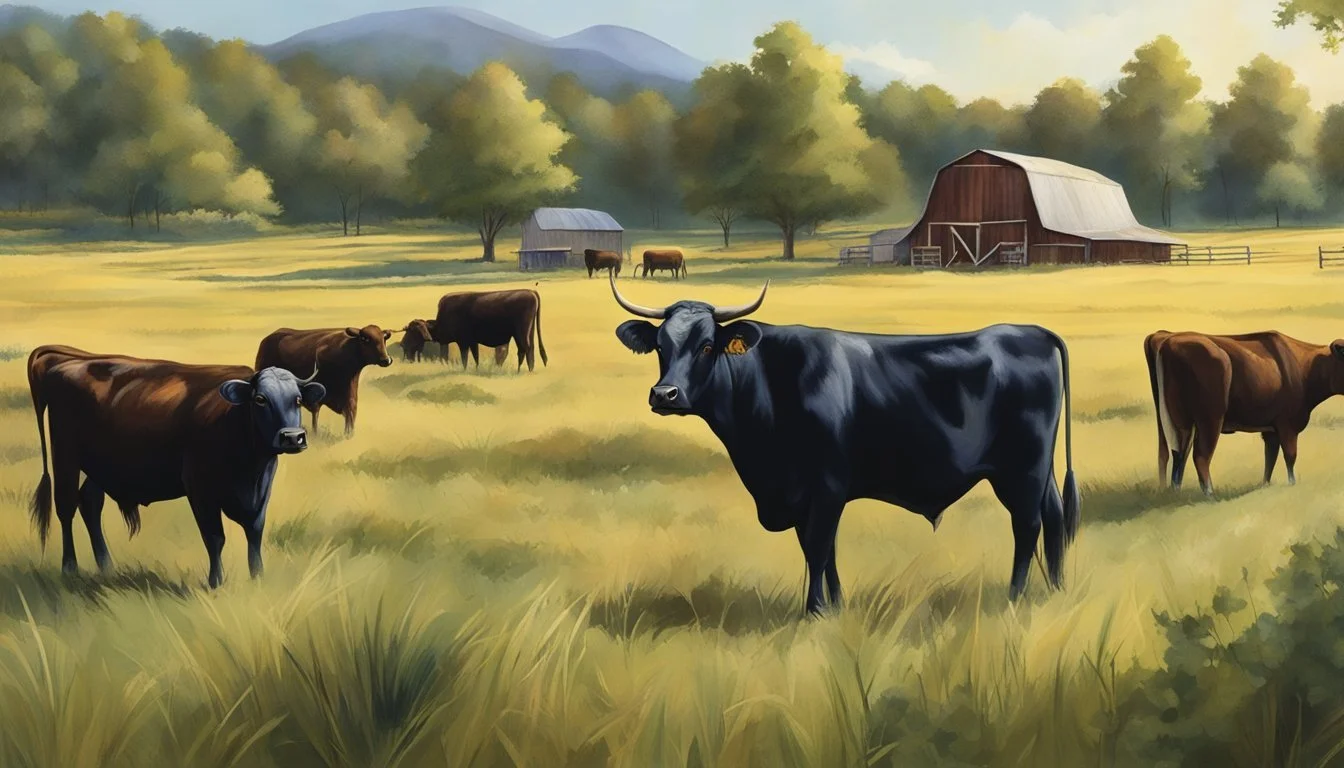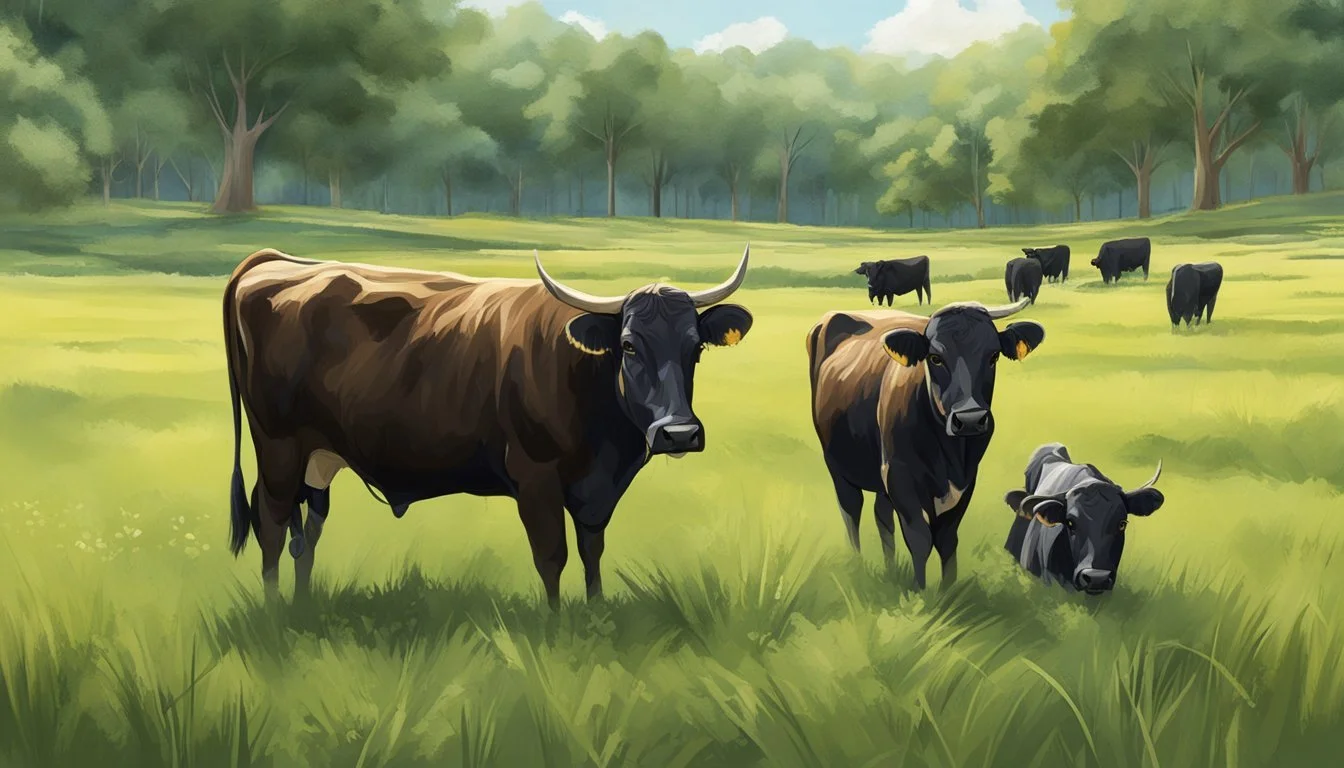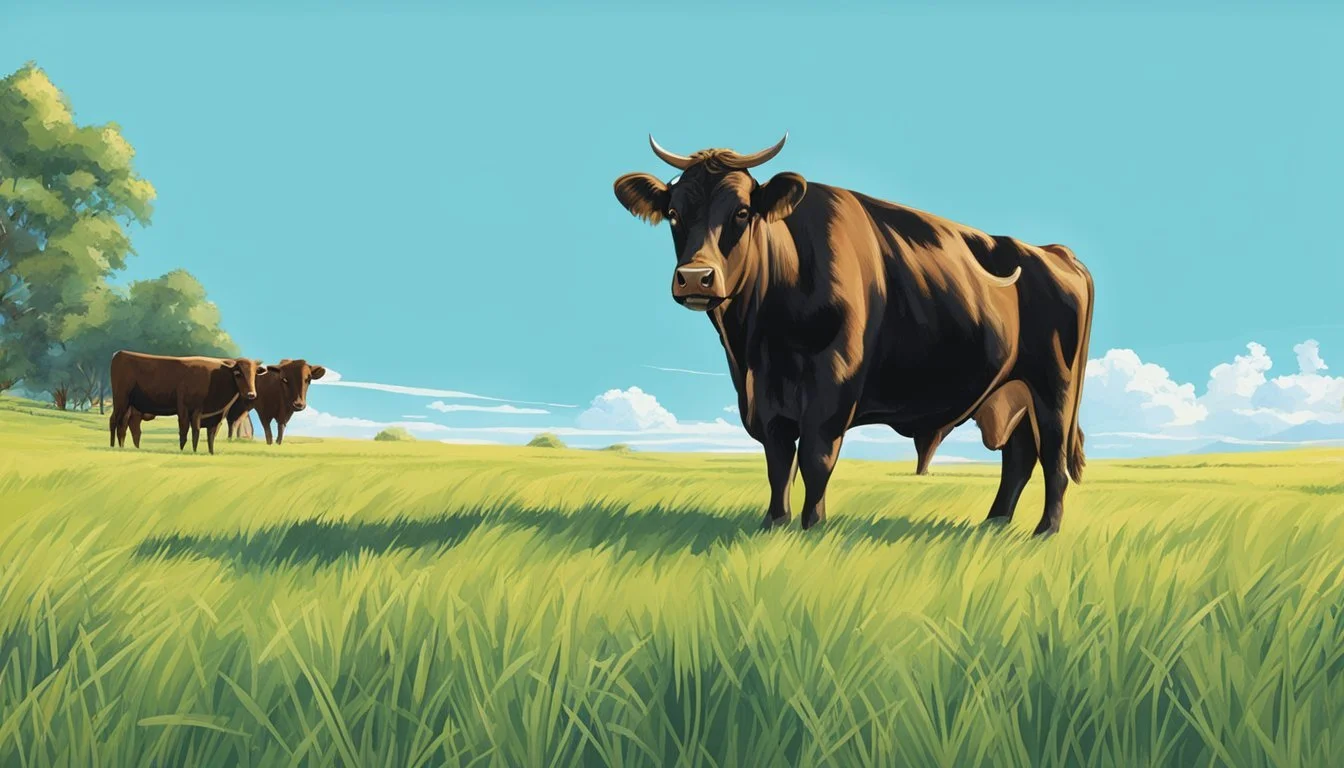Dexter Cattle Grazing Techniques
Optimize Your Land with Effective Pasture Management Strategies
Dexter cattle, a hardy and versatile breed, are well-suited for grazing on small homesteads due to their efficient feed conversion and smaller size. Their ability to thrive on less acreage makes them an optimal choice for maximizing pasture efficiency. Homesteaders aiming to optimize their land usage can employ specific grazing techniques tailored for Dexter cattle, ensuring both the health of the animals and the sustainability of the pasture.
Proper grazing management is a critical component in boosting productivity and maintaining the health of the pasture. A well-implemented rotational grazing system can lead to improved forage utilization, reduced feed costs, and enhanced soil fertility. By systematically rotating Dexter cattle through different pasture sections, homesteaders can manage the grazing pressure and allow for adequate recovery of grasses, which in turn supports both the cattle's nutritional needs and the ecological balance of the land.
In addition to rotational grazing, other practices such as monitoring pasture growth, careful stocking density decisions, and proactive pasture improvements, align with the principle of making the most out of available resources. These techniques not only support the well-being of Dexter cattle but also contribute to the overall goal of pasture efficiency on a homestead, aligning with sustainable agricultural practices and ensuring the longevity of the homestead's productivity.
Understanding Dexter Cattle Grazing Behavior
Dexter cattle are efficient grazers, known for their selective foraging habits and ability to maximize the nutritive value of pastures on homesteads. This section will explore their grazing patterns and how to assess their needs against pasture capacity.
Grazing Patterns and Forage Preferences
Dexter cattle exhibit distinctive grazing patterns, preferring a rich mix of forages. They adapt to various pasture types and often opt for the leafier and more nutritious parts of plants, such as the leaf over the stem. This selective behavior is beneficial as it can lead to better forage utilization and maintenance of the pasture quality.
Forage Types: Dexters are not restrictive and can graze on a range of forage, including grass, legumes, and mixed flora.
Daily Grazing Routine: They often graze during cooler parts of the day, typically in the early morning and late afternoon.
Grazing Distribution: Their grazing can be more uniform across the pasture, which prevents overgrazing of favorite spots and promotes even grass growth.
Evaluating Dexter Cattle Needs and Pasture Carrying Capacity
The balance between the number of cattle and the available pasture resources defines the carrying capacity and stocking rate. Properly managed pastures can support a sustainable number of Dexters without degrading the quality of the forage.
Carrying Capacity: Assessed by evaluating how much forage a pasture can produce and the amount of forage the cattle require.
Stocking Rate: The number of cattle the land can support year-round, adjusted for seasonal growth patterns and forage availability.
Key Considerations:
Cattle Weight and Growth: Heavier animals will have higher forage demands.
Land Size and Forage Yield: The productivity of the land dictates how many animals it can sustain.
Management Practices: Rotational grazing can help in managing forage regrowth and utilization efficiently.
By understanding the grazing behaviors of Dexter cattle and the pasture's carrying capacity, homesteaders can optimize grazing management for the best outcomes.
Fundamentals of Pasture Management
Effective pasture management is anchored in maintaining soil health and choosing appropriate plant species. These two aspects are critical for sustainable livestock grazing and overall environmental stewardship.
Soil Health and Fertility
Maintaining soil health is crucial for productive pastures. Soil fertility depends on balanced levels of nutrients and pH, the presence of organic matter, and proper soil structure. Soil tests should be conducted regularly to monitor nutrient levels and pH, enabling precise fertilizer application to avoid excess runoff. Incorporating organic matter, such as compost or manure, can enhance soil quality and promote beneficial microbial activity.
Soil Conservation: Employ techniques like rotational grazing to prevent soil compaction and erosion.
pH: Ideal soil pH for most pasture grasses ranges from 6.0 to 7.0.
Grass and Plant Species Selection
The selection of plant species is determinant for pasture efficiency. Opt for a mix of perennial grasses and legume species to create a balanced forage diet for Dexter cattle and improve soil health.
Pasture Grasses: Choose species well-suited to the local environment to minimize stress and disease.
Legume Species: Integrate legumes to naturally augment soil nitrogen levels.
To ensure a resilient ecosystem, include cover crops to protect and improve the soil during fallow periods. Proper plant selection can lead to a self-sustaining pasture that requires fewer inputs while providing quality forage.
Effective Grazing Systems and Strategies
Effective grazing systems and strategies are essential for preserving the vitality of pastureland and ensuring the well-being of livestock. They involve controlled grazing patterns, seasonal planning, and mitigation of overgrazing and erosion to enhance productivity and sustainability.
Rotational and Strip Grazing Techniques
Rotational grazing entails dividing a pasture into smaller areas known as paddocks and moving the cattle from one to another to allow forage in previously grazed paddocks to regenerate. Dexter cattle benefit from this system, as it prevents the overutilization of forage in any given area. Strip grazing, a more intensive form of rotational grazing, increases this efficiency by providing cattle access to small strips of pasture at a time and continually moving them forward.
Planning: Develop a detailed grazing plan that considers the growth rate of forages and the nutritional needs of the herd.
Implementation: Use electric fencing for cost-effective paddock and strip boundaries.
Adaptation: Remain flexible and adjust the strip size and relocation frequency based on forage availability and weather conditions.
Seasonal Grazing Planning and Drought Management
Developing a grazing calendar that accounts for seasonal variations in forage growth is crucial. During periods of slow growth, such as during drought, a grazing plan may include deferring grazing on certain pastures to promote recovery. Successful drought management strategies also involve:
Assessing forage inventory regularly to make timely decisions.
Incorporating drought-resistant forages into the grazing plan.
Good planning helps to maintain pasture productivity while conserving soil and resources.
Combating Overgrazing and Erosion
Overgrazing can lead to erosion and long-term pasture damage. It is critical to monitor for signs of overgrazing, such as shortened grass height and soil compaction. To counter these challenges:
Implement a management approach that prioritizes soil conservation.
Allow for adequate trampling by cattle, which can improve soil health when managed correctly.
Employ measures like planting cover crops and maintaining a diverse mix of forage species.
Preventative strategies, informed monitoring, and timely responses are all vital to ameliorating the effects of overgrazing and sustaining a healthy ecosystem.
Grazing Infrastructure and Pasture Division
To optimize grazing efficiency with Dexter cattle, the right infrastructure and strategic division of pastures are critical. These components ensure manageable pasture sizes and facilitate effective rotational grazing.
Fencing Systems: Permanent and Temporary Solutions
Permanent fencing is the backbone of an effective grazing infrastructure. It is typically constructed using materials like wood, wire, and t-posts that can withstand the test of time and contain livestock securely. For Dexter cattle, permanent fencing should:
Encircle the outer boundaries of pasture areas
Create paddocks that are a manageable size to support rotational grazing schedules
Temporary fencing, such as polywire or electric netting, offers flexibility and helps manage grazing patterns more actively. Temporary solutions allow a farmer to:
Subdivide larger paddocks for more intensive grazing
Adjust the grazing area based on growth rates and pasture condition
Easily move the barriers, which is less labor-intensive and more cost-effective than permanent structures
Water Distribution and Pasture Access
Water distribution within paddocks touches on the vitality of ensuring that Dexter cattle have a consistent and reliable water source. This may include:
Piped water systems that deliver water to various points in the pasture
Mobile water tanks when piped systems are not feasible, ensuring they are regularly replenished
A layout that allows the cattle to access water without traveling excessive distances, reducing energy expenditure and pasture damage
It’s important for the health of the pasture and the livestock that cattle can reach these water sources easily from any point within the paddock. Trail lanes or designated walkways can be used to minimize trampling and overgrazing in areas frequently traveled.
Monitoring and Adapting Grazing Practices
Effective grazing management on your homestead requires diligent monitoring and the flexibility to adapt practices in response to observed changes in pasture conditions and external environmental factors.
Pasture Condition and Productivity Assessment
The cornerstone of pasture management is a consistent assessment of pasture condition and productivity. To achieve this, homesteaders should:
Survey plant species: Determine the composition of plant species regularly and note any shifts that could affect forage quality and availability.
Measure forage mass: Use tools such as rising plate meters to quantify forage mass, aiming to optimize grazing at the stage of peak nutritional value.
Soil testing: Conduct periodic soil tests to monitor nutrient levels and soil composition, informing fertilization and amelioration strategies.
Responding to Environmental Changes and Pests
Grazing management must adapt to various environmental changes and the presence of pests to maintain pasture health and productivity. Key adaptive responses include:
Rotational grazing: Adjust grazing patterns based on climate impacts, allowing areas to recover and regrow, especially following extreme weather events.
Pest management: Identify pest species early, and implement integrated pest management tactics, considering biological controls and minimizing chemical use to protect beneficial species.
Through measured observation and informed adjustments, homesteaders can achieve a sustainable grazing system that supports both livestock nutrition and pasture longevity.
Enhancing Biodiversity and Ecosystem Health
Dexter cattle grazing techniques have shown promising results in boosting pasture ecosystem health and promoting ecological balance. When managed effectively, these techniques can significantly enrich biodiversity and improve wildlife habitats.
Promoting Wildlife Habitat and Ecological Balance
Dexter cattle, being smaller in stature compared to other cattle breeds, are less disruptive to the land. Strategic grazing patterns can improve the pasture ecosystem, fostering a mosaic of habitats that appeal to various wildlife species. Rotational grazing, for instance, allows pastures to recover and supports diverse plant growth. This variety in plant life can attract and sustain a wide range of insects, birds, and small mammals, contributing to a robust ecological balance.
Key actions to promote wildlife habitat and ecological balance:
Implement short, managed grazing periods.
Allow for adequate pasture recovery time.
Maintain hedgerows and other natural features.
By intertwining natural landscape features with grazing areas, farmers can enhance the habitat value of their land. Maintaining wooded areas, wetlands, and other natural ecosystems within or adjacent to grazing fields provides sanctuary and foraging opportunities for wildlife, helping sustain larger ecological networks.
Incorporating Livestock Diversity: Goats and Sheep
Introducing goats and sheep alongside Dexter cattle can further amplify pasture biodiversity. Each species of livestock interacts with the ecosystem in unique ways - goats are browsers that prefer shrubs and woody plants, while sheep often select for fine, leafy vegetation.
Benefits of livestock diversity include:
Different grazing habits that create a more varied vegetation structure.
Improved weed control through the selective feeding patterns of goats and sheep.
Minimized risk of overgrazing, as species-specific preferences distribute grazing pressure.
This diversity in livestock can help manage different plant species naturally, reducing the need for chemical interventions. Goats, with their propensity to clear brush, can be particularly effective in managing woodland fringes and preventing the spread of invasive species. By integrating these ruminants into a grazing strategy, farmers can promote a more resilient and self-regulating ecosystem.
Economic Factors and Cost-Effective Management
Maximizing pasture efficiency in Dexter Cattle Grazing involves critical evaluation of feed costs and land utilization while ensuring optimal animal welfare. Understanding the economics of feed and the strategic use of marginal land are fundamental for cost-effective and sustainable dairy farming and beef cattle production.
Analyzing Feed Costs and Pasture-Related Expenditures
Feed represents one of the largest expenses in cattle operations. A detailed breakdown of costs is crucial for financial planning and optimizing resource use:
Feed Costs: Assessing the cost-effectiveness of homegrown versus purchased feed options.
Pasture Maintenance: Estimating expenses for fertilization, seeding, and weed control.
Infrastructure: Including fencing, watering systems, and shelters in cost calculations.
Proper management practices can lower inputs while maintaining or improving cattle performance. Employing rotational grazing, for example, can increase forage utilization and potentially reduce the need for supplemental feed.
Utilizing Marginal Land and Enhancing Animal Welfare
Marginal lands, unsuitable for crops, can be effectively used for grazing, contributing to the overall efficiency of the operation. Incorporating such lands requires:
Adaptation: Dexter cattle are well-suited to diverse environments, making them ideal for converting less productive areas into valuable grazing land.
Grazing Plan: Developing a customized grazing strategy to maximize forage production and cattle health on marginal land, which can provide an economic return.
Animal welfare is intrinsically linked to management practices. Welfare-focused management can lead to healthier animals and, in turn, lower veterinary costs and higher production rates, positively impacting economic outcomes:
Shelter and Comfort: Providing adequate shelter and welfare-friendly facilities.
Health Monitoring: Establishing a routine health monitoring system to promptly address issues.
Grazing Innovations and Future Outlook
Grazing innovations are pivotal for the sustainability and optimization of pasture usage in homesteads rearing Dexter cattle. Recent advances in precision grazing technologies have shown potential for enhancing pasture efficiency and productivity.
Key Innovations:
Precision Measurement Tools: They measure forage biomass accurately, informing farmers about the optimum grazing intensity and timing.
Automated Monitoring Systems: These systems track cattle behavior and health, streamlining management decisions for improved welfare and production rates.
Future Trends in Dexter cattle grazing are likely to focus on technology integration and sustainability. Approaches such as adaptive grazing are gaining traction. They involve altering grazing patterns in response to environmental cues and cattle needs. The expectation is that these strategies will support:
Enhanced soil quality
Improved pasture yields
Increased cattle health and productivity
Sustainable Practices will continue to underpin future innovations. The utilitarian role of Dexter cattle in nutrient cycling promotes soil organic matter, aligning with ecological farming goals.
Anticipated advancements:
Data Analytics: For tailored feeding programs and genetic selection, contributing to a smaller ecological footprint.
Robotics and AI: To further reduce labor and refine grazing strategies, potentially reducing overgrazing and promoting pasture longevity.
In summary, Dexter cattle farmers can look forward to a range of helpful innovations tailored to improve pasture management and cattle health, while ensuring the longevity and productivity of their grazing systems.
Conclusion
Dexter cattle offer homesteaders a unique opportunity for efficient livestock production with their adaptability and moderate size. To maximize pasture efficiency, they need to be managed effectively.
Strategic Grazing
Implementing a rotational grazing system ensures that pastures are not overgrazed and have time to recover. Dividing grazing areas and controlling grazing periods promotes optimal forage regrowth and maintains soil health.
Regular Monitoring
Adequate monitoring of pasture quality, forage availability, and cattle health indicators is essential. By regularly assessing these factors, homesteaders can adjust their strategies in real-time to sustain high production levels.
Technological Enhancements
Incorporating precision agriculture tools where feasible can refine the efficiency of grazing tactics. Technology aids in making informed decisions based on concrete pasture and livestock data.
Sustainable Practices
Fostering a symbiotic relationship between Dexter cattle and their environment by using practices that nurture soil health contributes to the longevity of the homestead's productive capacity.
Training and Education
Continuous learning about pasture management practices is crucial for ongoing success. They should stay informed of new methodologies and findings in the field of sustainable grazing and livestock production.
By adhering to these principles, homesteaders can expect a robust grazing management framework that supports sustainable livestock production, preserving their homestead's viability for years to come.





